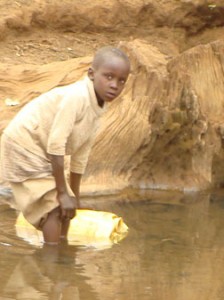 In nearly every corner of every country, unsustainable growth and human activities are compromising the quality and quantity of freshwater. Around the world, 1 in 3 people do not have enough water to meet their daily needs and 800 million people still rely on an unimproved water source, risking disease and even death with every sip.
In nearly every corner of every country, unsustainable growth and human activities are compromising the quality and quantity of freshwater. Around the world, 1 in 3 people do not have enough water to meet their daily needs and 800 million people still rely on an unimproved water source, risking disease and even death with every sip.
With traditional knowledge and personal investment in their environment and wellbeing, local people are positioned to protect water at the source. Grassroots groups are protecting our rivers, lakes, and water tables. Local activists are changing wasteful and polluting practices. Community-led projects are improving access for poor and rural families.
 Every April, the Aveda network raises over a million dollars to fund local water projects through Global Greengrants Fund. Over the years, their support has enabled hundreds of grassroots organizations to take action for clean, accessible water.
Every April, the Aveda network raises over a million dollars to fund local water projects through Global Greengrants Fund. Over the years, their support has enabled hundreds of grassroots organizations to take action for clean, accessible water.
Organizations in…
SRI LANKA
Currently, 70% of the world’s freshwater supply is used for agriculture, a practice that also contaminates water sources with hazardous pesticide runoff. In Sri Lanka, the Vikalpani National Woman Federation protects environmental and human health from pesticides, empowers rural women who have the greatest risk of exposure to these environmental hazards, and promotes ecological agriculture based on biodiversity to ensure food security and food sovereignty. In 2012, the organization began to collect information regarding the health of the communities that suffer from pesticide poisoning. Through education and advocacy, the organization aims to ban highly toxic pesticides from Sri Lanka altogether.
VIETNAM
Large hydroelectric dams irreversibly change our planet’s rivers. In Vietnam, The Center for Social Research and Development (CSRD) is committed to mitigating the negative effects of large dams on those living in poverty. As a coordinating agency for the Vietnam Rivers Network in central Vietnam, CSRD is engaged in an environmental assessment and scientific inquiry into the effects of two proposed dams on the Dong Nai River. Through careful social and economic assessments, CSRD will advocate for the 15 million people who use this waterway and make recommendations to policymakers on the socio-environmental impacts of the dams.
 CHINA
CHINA
Both innovative technology and traditional practices can offer sustainable alternatives to both protect and conserve water resources. In China, the Nanling Action Team works to promote sustainable agriculture, wildlife conservation, and diversified income generation. In the villages of Jiangxia, Xinjian, Lingtou, and Xindong, the group is promoting forms of income generation that also conserve natural resources, such as no-till agriculture, organic agriculture, traditional medicinal plant cultivation, and forest and watershed protection.
GUATEMALA
The burden of water insecurity is not distributed evenly across populations: the most vulnerable groups are impoverished, indigenous, and/or women. To that end, La Asociación para el Desarrollo Integral de Multiservicios (ADIM) is a community-based organization that focuses on cultural preservation and income equity in the Ixil region of Guatemala. With proposed dams threatening the water sources of indigenous communities, ADIM is collaborating with Guatemalan, American, and Italian lawyers, to help local people explore legal options for protecting their rights.
